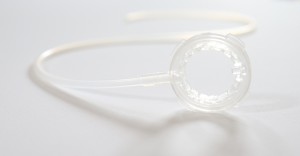 The LiVac Retractor comes in two sizes. The small will suit most left lobes of liver, and the large is intended for more secure retraction of the right lobe. Some larger left lobes of liver may be better retracted with the large LiVac Retractor.
The LiVac Retractor comes in two sizes. The small will suit most left lobes of liver, and the large is intended for more secure retraction of the right lobe. Some larger left lobes of liver may be better retracted with the large LiVac Retractor.- The LiVac Retractor is inserted through the wound created for a 12mm or larger port. Once inserted, the port lies alongside the tubing of the LiVac Retractor.
- The wound incision should be neither too tight (compressing the tubing), nor too large (CO2 leak).
- The LiVac Bevel is an optional-use accessory to replace the bevel (cone) on a Hasson port. It has a second channel for the LiVac suction tubing to exit alongside the Hasson port. If there is a CO2 leak alongside the tubing running next to a non-Hasson port, the bevel could also be used to seal this off.
- A high-pressure regulator must be used to control the pressure setting. Once all tubing connections between the regulator, suction canister, and standard suction hose are secure, clamp the suction hose and slowly turn the regulator to about -400mmHg to -500mHg. As it is a sealed system, the pressure cannot be turned down without first releasing the clamp to break the seal. It is best to achieve a stable pressure setting from the outset, so that when the LiVac tubing is connected and the clamp released, the vacuum pressure will then already have been set.
- In left lobe retraction, position the LiVac higher up on the dome of the liver (this will achieve better exposure of the hiatus), turn off the CO2 insufflation, and release the clamp on the suction hose. The pneumoperitoneum will collapse as the CO2 is drawn out and the liver is drawn to the diaphragm. Once the LiVac seal is attained, resume CO2 insufflation.
- In right lobe retraction, maintain continuous CO2 insufflation throughout. Grab the gallbladder in order to push the right lobe up against the LiVac and diaphragm and release the clamp to engage suction.
- When retraction is no longer required, disconnect the LiVac suction tubing from the suction hose to break the seal. You may wish to clamp the LiVac suction tubing to prevent CO2 leak.
It is normal to see some embossing of the liver surface straight after the LiVac is released. This will flatten out within 3 minutes, leaving a minimal mark or superficial bruise.

